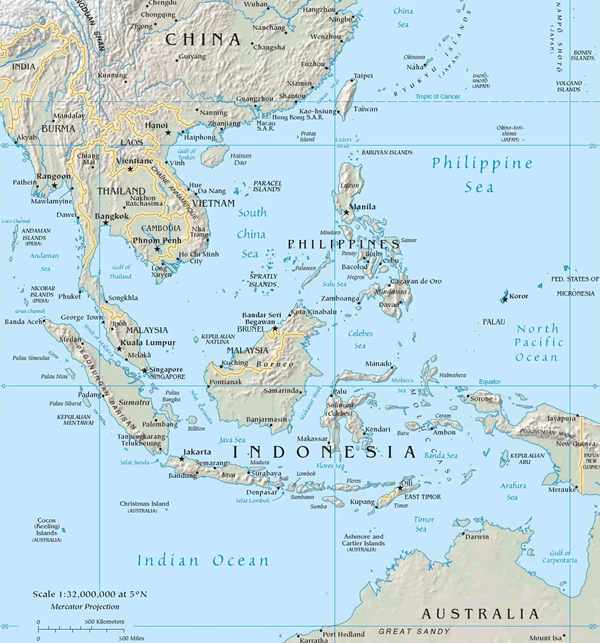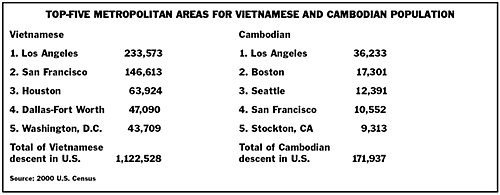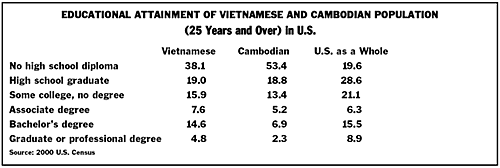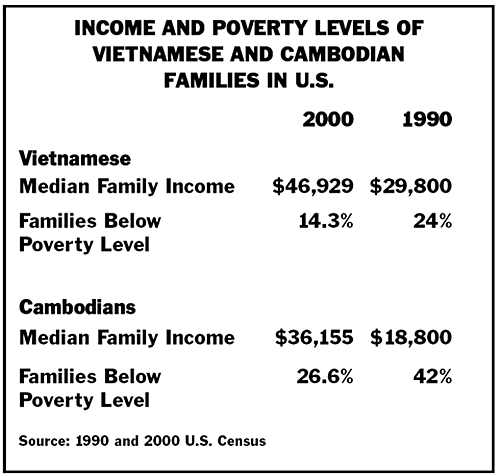History Lesson 8: Refugees From Vietnam and Cambodia
Please register to download a PDFs of this resource
Overview:
This lesson explores the massive immigration from Vietnam and Cambodia begun in the 1970s resulting from the end of the Vietnam War. It focuses particularly on the crisis caused by boat people fleeing the region, the Geneva Conference called to address the situation, and the subsequent resettlement of many of these refugees in the United States. In the activity, students look at refugees from Afghanistan and explore whether the United States owes a special obligation to refugees from countries in which it has fought wars.
Objectives:
Students will be able to:
- Describe the refugee crisis, its causes, and what was done to resolve it.
- Express a reasoned opinion on whether the United States owes a special obligation to resettle refugees from countries in which it fights wars.
Standards Addressed:
National Standard 27: Understands how the Cold War and conflicts in Korean and Vietnam influenced domestic and international politics. (2) Understands the political elements of the Vietnam War (e.g., . . . the legacy of the war)
National World History Standard 43: Understands how post-World War II reconstruction occurred, new international power relations took shape, and colonial empires broke up. II (3) Understands political and social change in the developing countries of . . . Asia after World War II (e.g., . . . major social and economic forces that compelled many Vietnamese to seek refuge in foreign countries)
California History-Social Science Standard 11.9: Students analyze U.S. foreign policy since World War II. Trace the origins and geopolitical consequences (foreign and domestic) of the Cold War and containment policy, including the following: . . . The Vietnam War.
Refugees From Vietnam and Cambodia
Beginning in 1965, the United States sent thousands of troops to aid South Vietnam in its war against communist Viet Cong guerrillas and North Vietnamese forces. U.S. involvement in the Vietnam War continued until 1973 when the United States pulled out the last of its troops from Vietnam. Communist troops then overran South Vietnam and by 1975 had defeated the South Vietnamese.
Over a million people have fled Southeast Asia since 1975. Many have come to the United States as refugees. Right after the fall of South Vietnam, a first wave of refugees began arriving in the United States. These people were usually well-educated and even wealthy Vietnamese. They had opposed the communists. About 125,000 of these Vietnamese resettled in this country. Starting in 1978, another wave of Vietnamese began to flee their country. These were the "boat people," who were poorer and not as well-educated as the Vietnamese who came in the first wave.
The Boat People
In 1978, the communist government in South Vietnam began to pressure some people to move from their city homes into the rural areas of the country. They put pressure especially on Vietnam's Chinese minority, long distrusted by the native Vietnamese. The Chinese living in Vietnam were threatened with being drafted in the army, losing their jobs, or being sent to rural "new economic zones" as laborers.
The following year, China attacked Vietnam over a border dispute between the two countries. This military action intensified the pressure on Vietnam's Chinese minority. Soon the Vietnamese government began encouraging the Chinese to leave the country altogether. Chinese families, many of whom had lived in Vietnam for generations, were forced to buy "exit permits," sometimes costing as much as $3,000 before they were allowed to leave. They fled by boat, paying to board small, leaky fishing boats or old freighters. Other Chinese and Vietnamese families, who hated food shortages and communist rule, left illegally without buying the government permits.
Since they all fled Vietnam by boat, they soon came to be called the "boat people." Once at sea, they struggled to survive. Shortages of water and food plagued them. Many fell ill. Boats capsized and sank. An estimated 200,000 boat people had drowned by the summer of 1979. Others were robbed, raped, and murdered by pirates. After drifting weeks at sea, the lucky survivors landed in Malaysia, Indonesia, the Philippines, or Hong Kong.
More refugees fled Southeast Asia when Vietnam invaded Cambodia in 1979 to overthrow the murderous regime of Pol Pot. Thousands of refugees from that unhappy land began to escape over the border into neighboring Thailand. By July 1979, about 400,000 Vietnamese and Cambodian refugees lived in temporary camps throughout Southeast Asia. The largest refugee camp was on the Malaysian island of Palou Bidong. There, 42,000 Vietnamese lived together in a one-square mile compound.
The so-called "nations of first asylum," the countries receiving the refugees, felt overwhelmed. They declared that they could not handle the thousands of people continuing to arrive each month. Malaysian officials even threatened to "shoot on sight" new arrivals who were coming at the rate of 65,000 a month. Thailand forced several thousand Cambodian refugees back into their war-torn homeland.

Vietnam and Cambodia are south of China and west across the South China Sea from the Philippines. (Perry-Castaneda Map Collection, University of Texas Library)
Geneva Refugee Conference
Because of the refugee emergency, the United Nations held an international conference at Geneva, Switzerland, in July 1979. Some nations, such as the United States, France, Australia, and Canada, were already admitting refugees from Southeast Asia. In June 1979, the United States had announced it would double the number of Southeast Asian refugees allowed to resettle in this country from 7,000 to 14,000 a month, but more people were still entering the crowded Southeast Asia refugee camps. The purpose of the meeting in Geneva was to see what could be done about slowing the flow of refugees and about resettling those living in refugee camps.

Vice President Walter Mondale represented the United States at the Geneva refugee conference. In a speech to those attending, Mondale recalled that a similar meeting 41 years before had failed to reach an agreement on the resettlement of European Jews on the eve of World War II. Later, 6 million Jews died in Hitler's death camps. The comparison of the Jewish Holocaust victims to the refugees dying daily in the waters of Southeast Asia was all too clear.
Mondale went on to declare that, "To alleviate the tragedy in Southeast Asia, we all have a part to play. The United States is committed to doing its share, just as we have done for generations." Mondale then reaffirmed the U.S. pledge of accepting 14,000 Southeast Asian refugees each month (168,000 a year). He also promised to ask Congress for additional refugee relief funds. Other countries at the conference made similar pledges, and even communist Vietnam said it would stop encouraging its citizens to leave the country.
Shortly after the Geneva conference, President Jimmy Carter ordered the Seventh Fleet, operating in the South China Sea, to look for and pick up "boat people" who continued to flee Vietnam.
Testifying before a Senate committee, Secretary of State Cyrus Vance said: "We are a nation of refugees. Most of us can trace our presence here to the turmoil or oppression of another time and another place. Our nation has been immeasurably enriched by this continuing process."

The "Boat People" in America
Most refugees who came to America from Southeast Asia arrived at Travis Air Force Base, 50 miles northeast of San Francisco. About 500 came every day. Like the immigrants at Ellis Island years ago, the refugees at Travis waited to be questioned by government officers. Their papers in order, the immigrants were bused to a hotel near the San Francisco airport from which they flew the following day to their new homes.
All the Southeast Asian refugees needed a U.S. sponsor. Often, refugees had relatives in the United States, who served this function. Sponsors provided housing, food, clothing, transportation, and were generally responsible for the refugee until he or she was self-supporting.
Those refugees without relatives in the United States had to wait for others to act as sponsors. Private individuals, churches, and service organizations in many communities throughout the United States volunteered to sponsor refugees.
Private organizations such as the International Rescue Committee, U.S. Catholic Conference, Lutheran Immigration and Refugee Services, and the Hebrew Aid Society helped the State Department find sponsors.
 From 1975 to 1979, these organizations placed over 220,000 refugees from Southeast Asia. The federal government spent over $1 billion to resettle these refugees in the United States. About 30 percent of them needed cash assistance when they first arrived. After a period of adjustment, most got jobs. The unemployment rate among Southeast Asian refugees was about the same as other workers. Since many came to the country speaking little English and with few skills, they usually ended up in low-paying jobs.
From 1975 to 1979, these organizations placed over 220,000 refugees from Southeast Asia. The federal government spent over $1 billion to resettle these refugees in the United States. About 30 percent of them needed cash assistance when they first arrived. After a period of adjustment, most got jobs. The unemployment rate among Southeast Asian refugees was about the same as other workers. Since many came to the country speaking little English and with few skills, they usually ended up in low-paying jobs.
Although the Vietnamese and Cambodian refugees moved all over the United States, many have remained in California. A large Vietnamese-American community resides in Orange County and a large Cambodian community is in Long Beach. (Both places are near Los Angeles.) Many Cambodians also live in Boston, Massachusetts. Today more than 1 million people of Vietnamese descent and 170,000 of Cambodian descent live in the United States.
For Discussion and Writing
- What were the causes of the flow of refugees from Southeast Asia?
- What was the refugee crisis? How was it resolved?
- What are some of the differences between the first wave of refugees from Southeast Asia, who came to the U.S. in 1975, and the "boat people," who began to arrive in 1978?
- On December 6, 1978, the 30th Anniversary of the Universal Declaration of Human Rights, President Carter said: "I hope we will always stand ready to welcome more than our fair share of those who flee their homelands because of racial, religious, or political oppression . . . ." Do you agree or disagree with this statement? Explain.
- Why do you think the United States agreed to take so many refugees from Vietnam and Cambodia? Do you think the United States had a special obligation to take them? Why or why not?
Activity
Refugees from Afghanistan
In 1979, the Soviet Union sent troops into Afghanistan, its neighbor to the south, in support of the Afghan communist regime that had seized power the year before. Rebels took up arms opposing the Soviets. The rebels were supported by the United States and Pakistan (which borders Afghanistan in the south). The ensuing fierce armed struggle led to a Soviet withdrawal in 1989 and contributed to the fall of the communist government in 1992. Warlords then fought for power in the country. By 1998, the Taliban, a fundamentalist Islamic group, had control of more than 90 percent of the country. The Taliban imposed a harsh rule, executing many and virtually condemning women to remain in their homes. The Taliban also permitted the terrorist group Al Qaeda to run training camps in the countryside. This group was responsible for the terrorist attacks on the United States on September 11, 2001. When the United States demanded that Afghanistan cooperate in turning over the leaders of Al Qaeda, the Taliban refused. So in 2002, the United States invaded Afghanistan, overthrew the Taliban, and searched for members of Al Qaeda. Today, the area around the capital city is under the control of forces friendly to the United States. The rest of Afghanistan is under the control of warlords, some of whom sympathize with the Taliban.
For the last 25 years, Afghanistan has been in turmoil. More than 4 million people have fled the warfare and today live in refugee camps in Pakistan and Iran (which borders Afghanistan in the west). These two countries have attempted to close their borders to further refugees.
In this activity, students will explore what obligation, if any, the United States owes these refugees.
- Divide the class into small groups.
- Each group should discuss and decide on these questions:
a. What do you think should be done with these refugees?
b. Should the United States actively seek to resettle Afghan refugees in the United States? Why or why not?
c. Does the United States owe a special obligation to resettle refugees from countries in which it fights wars? Explain.
| Lesson Plan 1 | Lesson Handouts 1 |
| Lesson Plan 2 |
Lesson Handouts 2 |
| Lesson Plan 3 |
Lesson Handouts 3 |
| Lesson Plan 4 |
Lesson Handouts 4 |
| Lesson Plan 5 |
Lesson Handouts 5 |


